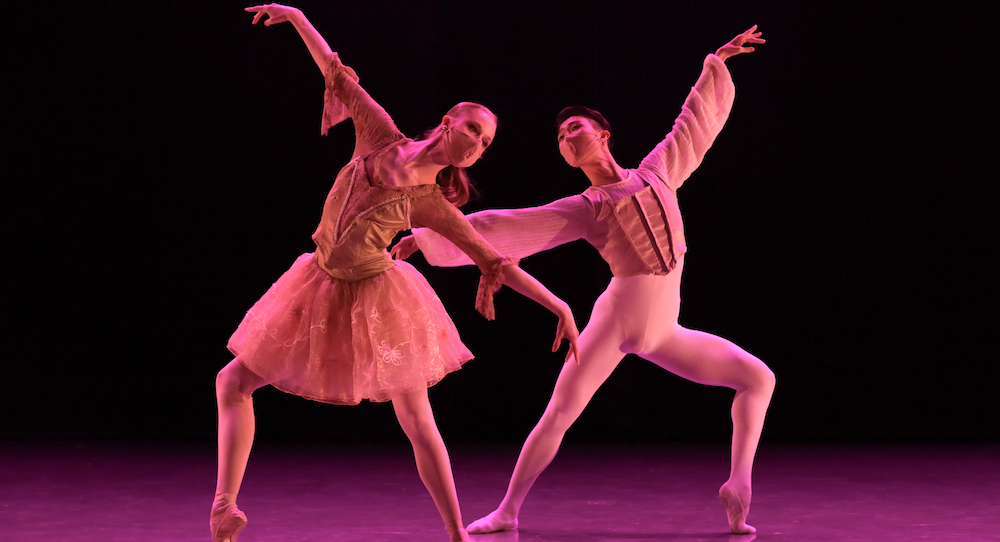Streaming on YouTube.
Released on March 25, 2021.
Reflecting the society in which it resides, the dance world has been having wide-ranging conversations around diversity, representation and equity. While we’ve come far, executive and creative leadership in dance is still a bit more male and whiter than many would like. A new generation of artists is also bringing their ideas, their values and their mindsets — and boldly asking for a seat at the table.
What will help change the face of this leadership and allow for the voices of young people to be heard — therein bringing important new perspectives and experiences to the work? What solutions will make lasting, rather than only cosmetic, change? The Joffrey Ballet (Chicago, IL) has one it has put forward — The Winning Works Choreographic Competition, an initiative to support promising young choreographers of color. The company has presented the “Winning Works” emerging from this program in an online festival, Winning Works 2021, available to all to enjoy free of charge through YouTube.
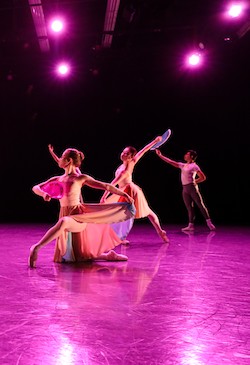
Pablo Sánchez’s ¡VIVA! opens the festival, bringing a lighthearted carnival feel — until the end illustrates something darker underneath. Twilight lighting sets the work in the nighttime, and skirts with expansive, billowy shapes and bright colors bring the aesthetic of carnival rides.
The lively instrumental score has a Latin rhythmic quality. It supports a breezy brightness and playful spirit in the movement — lifted and balletic without feeling overly formal or serious. Light and airy footwork is dynamic but not overly complex — a pleasure to experience. Masked, the dancers have to express emotion through their whole body rather than just their facial expressions. They do so joyfully.
Later, the choreography reflects Latin dance traditions — the dancers standing in vertical lines across the stage and footwork of stepping in quick rhythm. That footwork, along with hand-held fans and a soccerball, successfully help to build the sense of the culture at hand. Yet each incorporated only once, these elements don’t seem to offer all that they might have been able to — and even in a way feel a bit discordant. In a short work, every small choice can have a big impact, and it can certainly be a challenge to cohesively create the world one might want to build within that space.
A first section of the work closes with dancers posed in tableau and a burst of confetti. How festive! A big tonal shift, to something much less joyful, comes next through an extended solo — as a second major section of the work. The soloist’s lanky limbs and pliable spine makes possible a striking serpentine quality to her movement — much less classical and codified.
In that movement quality, dancing with the confetti underfoot and amidst her (when she executes movement vocabulary on the floor), she creates stark contrast to the section coming before hers. Her tight-fitting black unitard only enhances that sense of contrast, to the bright and billowy costumes of the dancers in the prior section — and also creates a feel of foreboding. The music is also more solemn and contemplative in tone.
Dancing alone, in a wrapping of all of these aesthetic qualities and their ensuing tonal effects, the soloist brings to mind a striking idea: while in community, even in a joyful atmosphere, there can be things that are left unsaid — the darker, more difficult things within us and between us that are easier to leave unexpressed and unresolved. !VIVA¡, while offering a joyful atmosphere in the beginning part of the work, also illustrates how the things that are left unsaid can move, can live, can breathe — and what they do to our heart, mind and soul as they do.
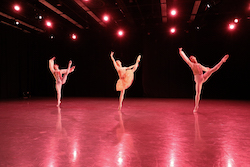
Durante Verzola’s Ballet de Cour is a highly classical work oozing with elegance. From the first pas de deux through varied other groupings and sections, classical grace and beauty prevails. The dancers offer lovely expression through épaulement, breathing easy through the movement to bring a lightness to it. They work together in pleasing harmony, creating geometry through their shapes and the between them. The score is a spritely instrumental one with a feeling of grandeur, pomp, and circumstance. The costumes are also traditionally classical, but have cuts and colors that make them fresh.
Toward the middle of the work, ballerinas create an accumulating group — growing larger with more dancers joining — moving with softness and poise. Following them is a group of danseurs moving with striking speed and power. While I at times feel like so explicitly delineating gender binaries can feel reductive to the versatility of both male and female dancers, the effect is pleasing aesthetically and perhaps par for the course with such a classical piece.
Many other structural shifts follow, bringing a dynamism that makes you not quite know what to expect next. The ending has dancers posing on a dime — in perfect unison — and then lights and music quickly cut out. This choice is fitting for a work so centered on presentational elegance. The dancers carry themselves like royalty throughout, and finish the work in the same way.
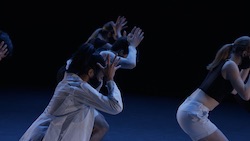
Tsai Hsi Hung’s Brushstrokes is much more contemporary in movement quality and tone than the prior two works, full of mystery and ambiguity. Dancers begin spread out through space, some facing upstage while others move facing downstage. As they dance in that formation and in subsequent ones, they don’t interact with one another, yet the sum of their moving bodies makes up a larger picture that puts them into conversation — just like brushstrokes in a painting.
The movement quality is fast and athletic (apart from one section in the middle that brings a tempo shift to something slower and more contemplative). It’s grounded but also at times puts dancers leaping high into space. The choreography makes hungry use of the stage space in three dimensions. The score has an ominous, mysterious feel, with an urgency that supports the quick and athletic movement.
The costumes feel almost like perversions of black tie formal dress — all black and white in sometimes strange (but close fitting) shapes, such as one leg of pants as pants and the other leg as shorts and (on another dancer) white shirt tails popping out from the front of a black vest just on one side. All the different variations on this theme are candy for the eye, perhaps a candy with a sour taste before the sweet.
At first, how these ingredients fit together — and fit with the title — feels a bit puzzling to me. Yet, I begin to think about the underlying energies of a formal event — the things left unsaid, the perhaps competing wills — the qualities of all of that perhaps not aligning with all of the handsome, pleasing formalism of outward appearances and pleasantries. Yet in all of that opulence and elegance can be subtle nuances evincing those more difficult things left unsaid, if you look closely — like brushstrokes in a painting.
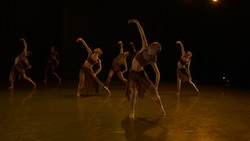
Chanel DaSilva’s Borders thoughtfully paints a moving picture of delineation and isolation. It opens on a large cast standing in a line, rising and falling in space, gesturing and gazing intentionally. Low ambers illuminate the stage, which aesthetically aligns with costumes of earth tones. The speed and size of the movement increases as they move through varied formations.
The dancers take up stage space liberally and enthusiastically through these formations. Yet interaction between the dancers isn’t present; there is both physical and social distance between them. As also seen in Hung’s piece, they make a stage picture together without interfacing as souls.
That changes as most of the cast exits and in a duet, it seems we finally see two souls seeing each other as souls. Apart from literal gaze, there’s connection between them in their body language and simply somehow in the air. The larger cast returns and although they still move apart in space, that new energy of connection remains. A new lift of the heart and an overall lifted feeling of the torso also brings a new feeling of hope and light. The actual stage lights rise to literally reinforce that feeling of new light.
Yet, still there is turbulence, and the score reverts to the tense, urgent quality of earlier in the work — and movement again becomes fast, athletic and turbulent. Ominously, the line of the beginning of the work returns in the ending section. Things move in cycles, and regression occurs in individuals and collectives. The piece’s turn of events seems to underscore that as an important truth. Yet, within that cycle, that new light and hope was experienced — better than not having experienced it at all.
Better to experience these works through a screen than not at all. Much better to experience voices with diverse backgrounds and perspectives, even if it takes intentionality and hard work, than to experience a narrow set of perspectives. Brava and thank you to The Joffrey Ballet for putting in that work and acting with that intentionality through the Winning Works initiative, and through that bringing us these thought-provoking, satisfying works of dance art.
By Kathryn Boland of Dance Informa.


